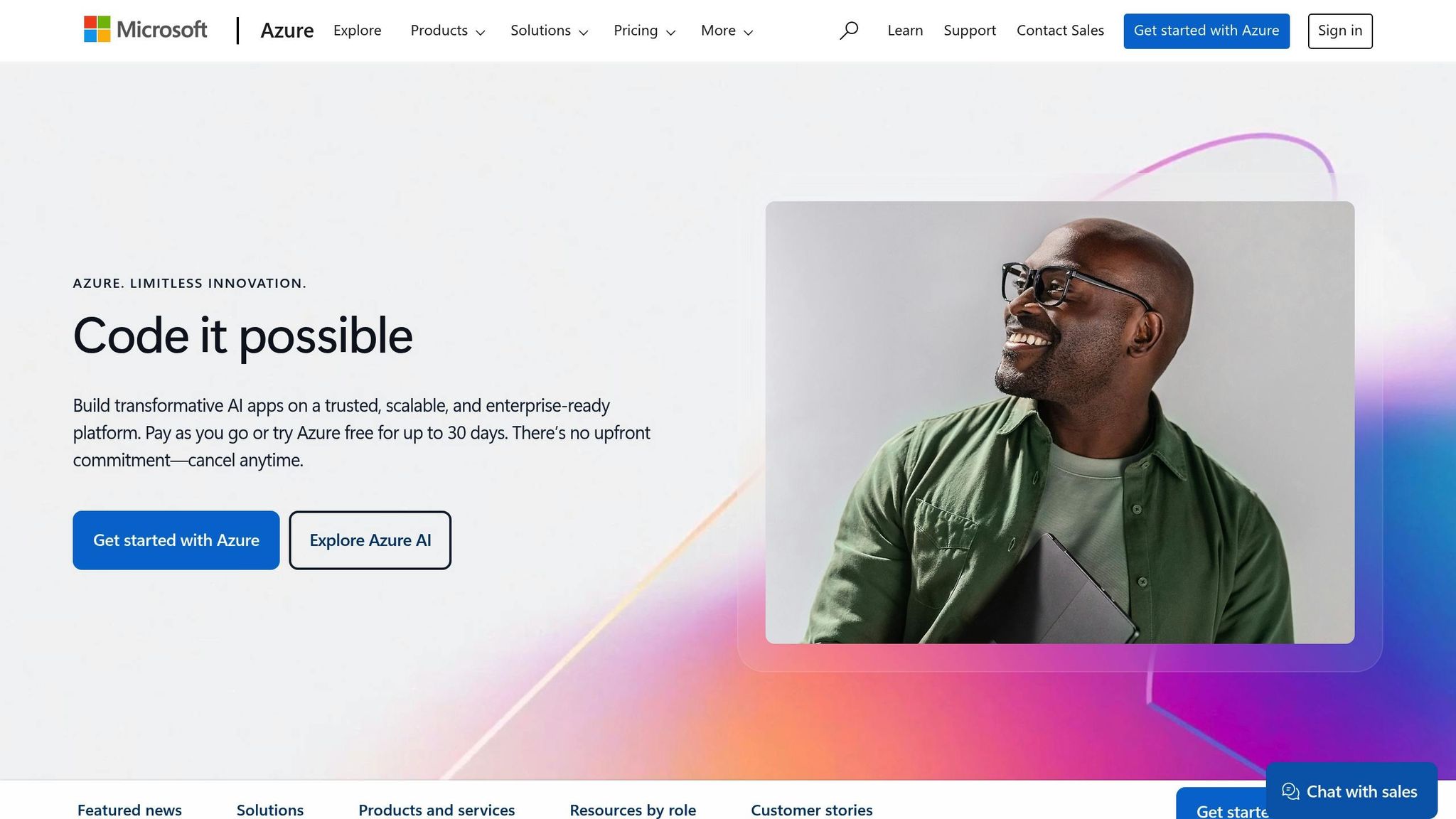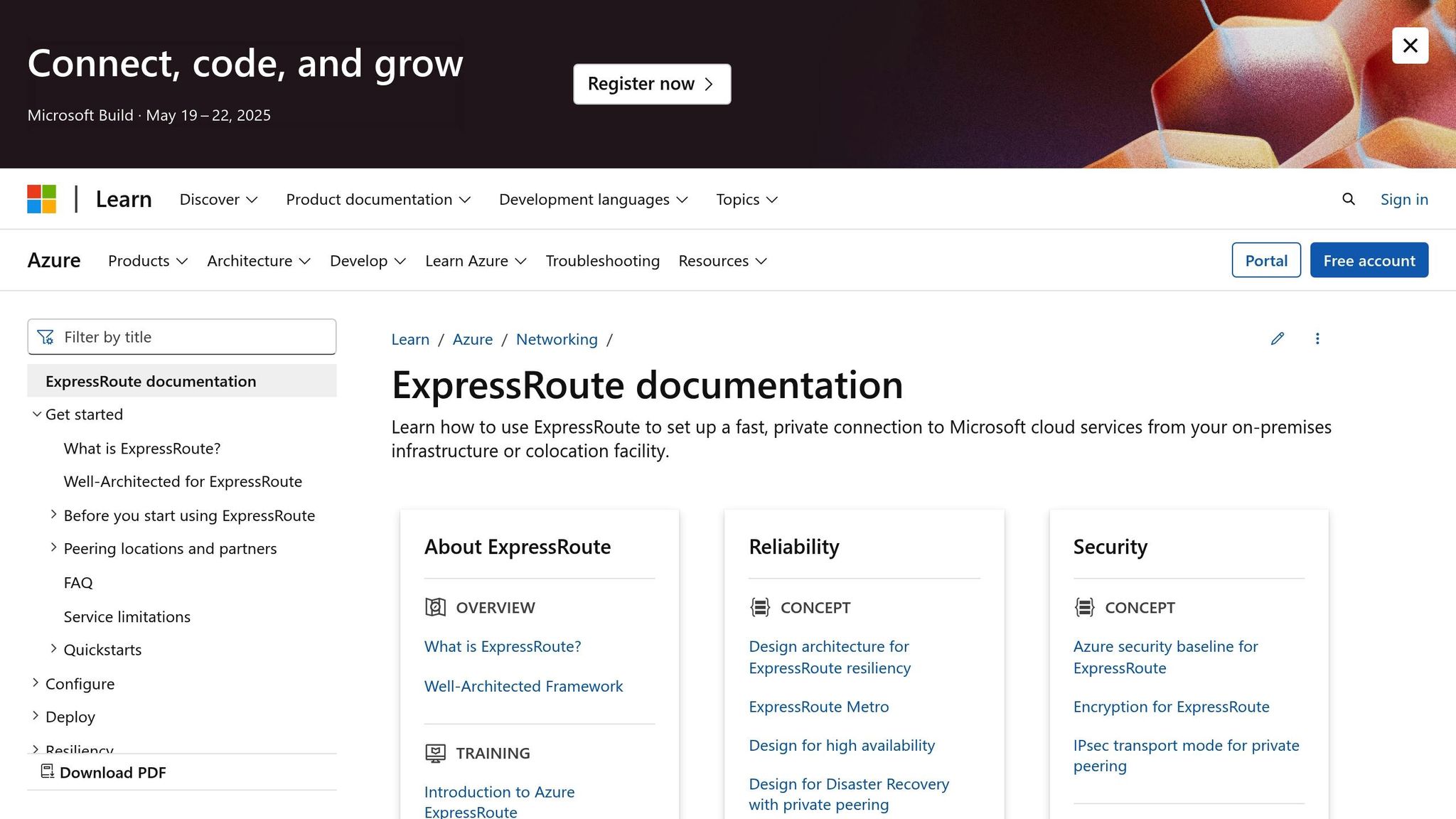Checklist for Securing Azure Data in Transit
Learn essential strategies to secure data in transit on Azure, including TLS, network security, hybrid connections, access controls, and monitoring.

Protecting data in transit is critical for businesses using Azure. Here's a quick guide to ensure your data stays secure:
- Use TLS 1.2+: Encrypt data during transmission and disable weaker protocols.
- Manage Certificates: Store and auto-renew TLS certificates in Azure Key Vault.
- Enforce HTTPS: Activate HTTPS-only mode and configure HSTS for secure connections.
- Strengthen Network Security: Use Network Security Groups, Azure Firewall, and DDoS protection to filter and monitor traffic.
- Secure Hybrid Connections: Encrypt site-to-site VPNs and configure ExpressRoute with private peering.
- Control Access: Enable Multi-Factor Authentication (MFA) and Role-Based Access Control (RBAC).
- Monitor Security: Use Azure Defender, Sentinel, and Network Watcher for real-time threat detection and compliance tracking.
Quick Tip: Regularly review and update your security configurations to stay ahead of emerging threats.
For detailed steps and configurations, read on.
Azure Encryption 101

TLS Setup for Data Protection
These TLS configurations are part of Azure's overall approach to securing data.
Set Up TLS 1.2+
Follow these steps to implement TLS 1.2+:
| Service Type | Required TLS Version | Priority |
|---|---|---|
| App Services | TLS 1.2 minimum | Critical |
| API Management | TLS 1.2 minimum | Critical |
| Azure Functions | TLS 1.2 minimum | Critical |
| Azure Storage | TLS 1.2 minimum | Critical |
- Enable TLS in your service settings.
- Disable TLS 1.0 and 1.1 to eliminate weaker protocols.
- Choose strong encryption algorithms for enhanced security.
- Ensure clients support TLS 1.2 or higher.
Proper certificate management is essential for maintaining secure and uninterrupted encryption.
Certificate Management
Leverage Azure Key Vault for secure storage and automated management of TLS certificates.
-
Certificate Storage and Renewal
- Store all TLS certificates in Azure Key Vault.
- Set up alerts and enable auto-renewal to handle upcoming certificate expirations.
- Keep an up-to-date inventory of certificates.
-
Monitoring
- Use Azure Monitor to track certificate statuses.
- Send notifications to your security team for any issues.
- Generate monthly reports to review certificate health and compliance.
HTTPS and Encryption Settings
Ensure HTTPS and encryption settings align with best practices:
| Setting | Objective | Priority |
|---|---|---|
| Enforce HTTPS | Activates HTTPS-only mode and HSTS | High |
| Minimum TLS | Sets the encryption standard to TLS 1.2+ | Critical |
| Secure Protocols | Limits allowed protocols to strong options | High |
For App Services and APIs, take these actions:
- Turn on HTTPS-only mode to enforce secure connections.
- Configure HSTS (HTTP Strict Transport Security) for added protection.
- Require TLS 1.2 or higher for all communications.
- Allow only strong encryption protocols to minimise vulnerabilities.
Network Security Setup
To ensure data in transit remains secure, it's crucial to combine TLS and certificate best practices with strong network configurations. Tools like Network Security Groups (NSGs), Azure Firewall, and DDoS Protection work together to safeguard your network traffic.
Network Security Group Rules
Here’s how to configure essential NSG rules:
| Rule Component | Configuration | Priority |
|---|---|---|
| Inbound Traffic | Deny all by default | 100 |
| Internal VNet | Allow specified ports | 200 |
| Management Access | Restrict to authorised IPs | 300 |
| Application Traffic | Allow specific services | 400 |
- Group virtual machines using Application Security Groups (ASGs) for simplified management.
- Enable NSG flow logs to monitor and analyse traffic patterns.
- Review and update rules every quarter to address emerging threats.
- Follow the principle of least privilege, granting only the necessary access.
Azure Firewall Configuration
-
Network Rules
Set up strict filters based on source, destination, protocol, and port for sensitive data pathways. -
Application Rules
Control outbound HTTP/HTTPS traffic by allowing only trusted fully qualified domain names (FQDNs). -
Private Endpoints
Use private endpoints to ensure traffic remains within Azure's secure infrastructure.
DDoS Protection Setup
Proper DDoS protection involves configuring these features:
| Feature | Purpose | Configuration |
|---|---|---|
| Adaptive Tuning | Automatically adjusts thresholds | Enable for all protected resources |
| Attack Analytics | Provides real-time attack insights | Set alerts every 15 minutes |
| Mitigation Reports | Offers post-attack analysis | Automate reporting for review |
- Set up metric alerts to detect potential attacks early.
- Enable automatic mitigation for workloads that are critical to operations.
- Define notification thresholds based on typical traffic levels.
- Test your DDoS defences regularly using simulated attacks in a controlled, non-production environment.
Hybrid Connection Security
Securing hybrid connections between on-premises systems and Azure requires strong encryption and proper key management. This layered approach ensures that data stays protected during transit across different environments. Start by configuring VPN and ExpressRoute settings, followed by managing keys to safeguard all hybrid connections.
VPN Encryption Setup
For site-to-site VPNs, activate IPsec with up-to-date IKE protocols, strong encryption, and hash algorithms. Implement perfect forward secrecy for added protection. For point-to-site VPNs, use Azure Certificate Authentication with secure key lengths. Limit split tunnelling and use packet filters to allow only approved Azure traffic.
ExpressRoute Security

When using ExpressRoute, make sure private peering is configured correctly. Enable BGP authentication and apply route filtering to block unauthorised routes. Keep an eye on the connection to detect any unusual activity.
Key Management
Leverage Azure Key Vault with automation for seamless key rotation. Store keys in a geo-redundant repository with soft-delete enabled, and maintain an encrypted offline backup as an extra precaution. Regularly update your processes to keep up with changing security requirements.
Access Control Setup
Building on earlier network and encryption measures, access control limits who can start or modify data transfers. This approach strengthens data security during transit by reducing access to authorised users only, using robust authentication and authorisation methods.
MFA Implementation
Enable Multi-Factor Authentication (MFA) for all Azure user accounts. Enforce this through Conditional Access policies, considering factors like user location and device status.
RBAC Setup
Implement Role-Based Access Control (RBAC) using the principle of least privilege. Custom roles should limit users to only the actions necessary for their tasks, such as:
| Role Type | Access Level | Use Case |
|---|---|---|
| Storage Data Reader | Read-only | Monitoring data flow |
| Storage Data Contributor | Read/Write | Managing data pipeline operations |
| Key Vault Secrets User | Secret retrieval | Accessing encryption keys |
After setting up RBAC, focus on securing service connections with managed identities.
Managed Identity Configuration
Leverage system-assigned managed identities to eliminate the need for storing credentials. Use user-assigned identities when permissions need to be shared across multiple services.
Configure Azure Key Vault access policies to grant managed identities only the permissions they need to access encryption keys and certificates. To enhance security, enable soft delete and purge protection, reducing the risk of accidental identity removal.
Steps to strengthen identity configuration:
- Enable identity-based authentication.
- Limit network access to token endpoints.
- Use Azure Monitor and Security Center to track identity usage and detect anomalies.
Security Monitoring Setup
Strengthen your data protection by implementing effective security monitoring methods.
Security Tools Setup
Use Azure Defender for Cloud as your main security monitoring tool. Here's how to configure its key components:
| Monitoring Component | Purpose | Configuration |
|---|---|---|
| Just-in-Time VM Access | Manages inbound traffic | Enable |
| Adaptive Network Hardening | Examines traffic patterns | Configure |
| Network Map | Displays data flow visually | Update daily |
Additionally, set up Azure Sentinel to monitor critical activities like:
- Status of certificates
- Schedules for encryption key rotation
- Changes in network security groups
- Failed authentication attempts
These tools work alongside encryption and access controls to provide real-time threat detection.
Data Flow Tracking
To enhance security, continuously monitor network traffic for unusual patterns. Configure Azure Network Watcher with Flow Logs and Traffic Analytics using these settings:
- Processing interval: 10 minutes
- Data retention: 30 days
- Geo-mapping: Enabled
- Malicious IP detection: Enabled
For deeper insights, use Network Performance Monitor to measure latency and packet loss in critical data paths.
Policy Configuration
Maintain a strong security foundation by applying these policies:
- Encryption Requirements: Enforce the use of TLS 1.2 or higher and approved cipher suites.
- Monitoring Standards: Ensure all networking resources have diagnostic settings and threat detection alerts.
- Compliance Tracking: Use the Azure Policy Compliance dashboard with automated fixes for non-compliant resources.
Set up Azure Monitor alerts to notify you about:
- Unusual data transfer patterns
- Policy violations
- Authentication issues
- Certificate-related events
These measures help ensure your security monitoring setup remains effective and up-to-date.
Summary
Protect Azure data in transit with these five key layers:
TLS Configuration
Ensure the use of TLS 1.2 or higher with managed certificates to safeguard data during transmission.
Network Security
Leverage Network Security Groups (NSGs) and Azure Firewall to control traffic and prevent unauthorised access.
Hybrid Connections
Secure hybrid traffic through VPNs (using IPsec encryption and dedicated tunnels) or ExpressRoute (offering private connectivity with optional encryption).
Access Controls
Implement Multi-Factor Authentication (MFA) and Role-Based Access Control (RBAC) to restrict access effectively.
Security Monitoring
Utilise Azure's security tools to keep a constant watch for potential threats.
For small and medium-sized businesses expanding their Azure infrastructure, these measures are essential. Balancing security with cost efficiency is crucial, and regular updates and assessments ensure your data remains protected as your organisation grows.
For more guidance on managing security and costs on Azure, check out Azure Optimization Tips, Costs & Best Practices.
FAQs
What steps can I take to keep my Azure TLS certificates secure and up-to-date?
To ensure your Azure TLS certificates remain secure and up-to-date, follow these key steps:
- Automate certificate renewal: Use Azure Key Vault to manage and automatically renew your TLS certificates, reducing the risk of expired certificates.
- Monitor certificate expiry: Set up alerts in Azure Monitor to notify you well in advance of certificate expiration.
- Apply strong encryption standards: Ensure your certificates use the latest encryption protocols, such as TLS 1.2 or higher, to maintain robust security.
By implementing these practices, you can minimise risks and maintain secure data transmission across your Azure services.
What are the best practices for setting up Network Security Groups (NSGs) to secure data in transit on Azure?
To enhance data protection in transit, Network Security Groups (NSGs) should be configured carefully to control traffic flow. Follow these best practices:
- Define specific rules: Only allow traffic that is essential for your application, blocking unnecessary ports and protocols.
- Prioritise rule order: Ensure rules are arranged correctly, as Azure processes them in priority order (lower numbers first).
- Use application security groups: Group resources logically to simplify rule management and reduce complexity.
- Monitor and log activity: Enable NSG flow logs to track traffic patterns and identify potential threats.
By implementing these steps, you can significantly improve the security of your data in transit while maintaining efficient network performance.
How do Azure's Multi-Factor Authentication (MFA) and Role-Based Access Control (RBAC) enhance data security during transit?
Azure's Multi-Factor Authentication (MFA) and Role-Based Access Control (RBAC) work together to provide robust protection for data in transit by ensuring that only authorised individuals can access sensitive resources. MFA adds an extra layer of security by requiring users to verify their identity through multiple methods, such as a password and a mobile app notification. This reduces the risk of unauthorised access due to compromised credentials.
RBAC complements this by assigning specific permissions to users or groups based on their roles, ensuring they can only access the data and resources necessary for their tasks. By combining MFA with RBAC, Azure ensures that even if a user's credentials are compromised, the attacker would still face significant barriers to accessing sensitive data during transit.




